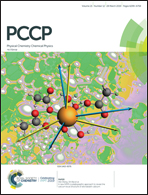Substituent effects in the so-called cation⋯π interaction of benzene and its boron–nitrogen doped analogues: overlooked role of σ-skeleton†
Abstract
Despite massive efforts to pinpoint the substituent effects in the so-called cation⋯π systems, no consensus has been yet reached on how substituents exercise their effects in the interaction of the aromatic molecule with the metal ion. The π-polarization (the Hunter model) and the direct local effect (the Wheeler–Houk model) are two lines of thought applied to this problem, but the justification of both approaches is based on insufficiently proven assumptions and approximations. In order to shed more light on this issue we propose a new approach which enables us to gauge directly the energetic trends resulting from the interaction of the ring with the cation. In our method we add one more partitioning level to the interacting quantum atoms (IQA) scheme and decompose the IQA interaction energies into contributions resulting from σ and π electron densities of the aromatic ring. The new approach, which is named partitioned-IQA, abbreviated as p-IQA, has been applied to complexes of derivatives of benzene or azaborine interacting with a sodium cation. The p-IQA approach reveals that in these systems both σ and π electronic moieties are polarized. Interestingly, for the majority of cases the σ-polarization outweighs the π one, contrary to the Hunter model. However, the Wheeler–Houk model is not precise, either, since the σ-polarization shows some degree of non-locality. In addition, the substituents are found to have a negligible influence on the ring orbital-overlapping capability, i.e. the covalency. Therefore, the substituent effect in the cation⋯π interaction is a nonlocal classical effect, indicating that neither Hunter model nor Wheeler–Houk model is able to fully describe all the aspects of the substituent effects. The p-IQA conclusions for the considered systems have been compared with the results from the functional-group SAPT (F-SAPT) method. We believe that the presented partitioning in the IQA framework will provide a deeper insight into the substituent effects in the cation⋯π interactions, which is beyond the σ–π atomic charge population separation.



 Please wait while we load your content...
Please wait while we load your content...